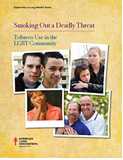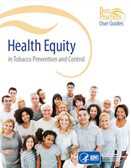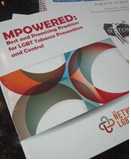Lesbian, Gay, Bisexual, and Transgender Persons and Tobacco Use
People who are lesbian, gay, bisexual, or transgender (LGBT) include all races and ethnicities, ages, and socioeconomic groups, and come from all parts of the U.S. It is estimated that lesbian, gay, and bisexual (LGB) persons make up approximately 3% of the total U.S. population.1
Cigarette smoking among LGB individuals in the U.S. is higher than among heterosexual/straight individuals. Nearly 1 in 4 LGB adults smoke cigarettes compared with about 1 in 6 heterosexual/straight adults.2
Cigarette Smoking Prevalence
23.9% of LGB adults smoke cigarettes compared to 16.6% of straight adults.2

* Data taken from the 2014 National Health Interview Survey and refer to adults aged 18 years and older.
Transgender Individuals
Limited information exists on cigarette smoking prevalence among transgender people; however, cigarette smoking prevalence among transgender adults is reported to be higher than among the general population of adults.3
The transgender population is considered especially vulnerable because of high rates of substance abuse, depression, HIV infection, and social and employment discrimination, all of which are associated with higher smoking prevalence.4
Health Effects
- More than 30,000 LGBT persons die each year of tobacco-related diseases.5
- Gay men have high rates of HPV infection which, when coupled with tobacco use, increases their risk for anal and other cancers.5
- LGBT individuals often have risk factors for smoking that include daily stress related to prejudice and stigma that they may face.7,8
- Bartenders and servers in LGBT nightclubs are exposed to high levels of secondhand smoke.9
- Among women, secondhand smoke exposure is more common among non-smoking lesbian women than among non-smoking straight women.10
Quitting Behavior
- LGB individuals are 5 times more likely than others to never intend to call a smoking cessation quitline.11
- LGBT individuals are less likely to have health insurance than straight individuals,6,12 which may negatively affect health as well as access to cessation treatments, including counseling and medication.
- Gay, bisexual, and transgender men are 20% less likely than straight men to be aware of smoking quitlines despite LGBT individuals having exposure to tobacco cessation advertising similar to straight individuals’ exposure.13
Tobacco Industry Marketing and Influence
High rates of tobacco use within the LGBT community are due in part to the aggressive marketing by tobacco companies that sponsor events, bar promotions, giveaways, and advertisements.4,5,14
- Tobacco companies advertise at “gay pride” festivals and other LGBT community events and contribute to local and national LGBT and HIV/AIDS organizations.5
- Tobacco advertisements in gay and lesbian publications often depict tobacco use as a “normal” part of LGBT life.4
- The tobacco industry encourages menthol cigarette use among LGBT populations.14
- Approximately 36% of LGBT smokers report smoking menthol cigarettes compared to 29% of heterosexual/straight smokers.14
- The marketing campaign, Project SCUM (Sub-Culture Urban Marketing), was created in the mid-1990s by a tobacco company to target LGBT and homeless populations.15

Culturally appropriate anti-smoking health marketing strategies and mass media campaigns like CDC's Tips From Former Smokers national tobacco education campaign, as well as CDC-recommended tobacco prevention and control programs and policies, can help reduce the burden of disease among the LGBT population.
Resources
- The Last Drag: Free Quit Smoking Class for LGBT and HIV+ Smokers
- LGBT HealthLink
- Truth Initiative
- Smoking Cessation Leadership Center
- Americans for Nonsmokers’ Rights
References
- Ward BA, Dahlhamer JM, Galinsky AM, Joestl SS. Sexual Orientation and Health Among U.S. Adults: National Health Interview Survey, 2013 [PDF–194 KB]. Atlanta: Centers for Disease Control and Prevention, National Center for Health Statistics, 2014 [accessed 2016 Mar 18].
- Centers for Disease Control and Prevention. Current Cigarette Smoking Among Adults—United States, 2005–2014. Morbidity and Mortality Weekly Report 2015;64(44):1233–40 [accessed 2016 Mar 17].
- Buchting FO, Emory KT, Scout, Kim Y, Fagan P, Vera LE, Emery S. Transgender Use of Cigarettes, Cigars, and E-cigarettes in a National Study. American Journal of Preventive Medicine 2017. In Press [cited 2017 Feb 17].
- American Lung Association. The LGBT Community: A Priority Population for Tobacco Control [PDF–367 KB]. Greenwood Village (CO): American Lung Association, Smokefree Communities Project [accessed 2016 Mar 17].
- The DC Center for the LGBT Community. Smoking and the LGBT Community. Washington DC, 2015 [accessed 2016 Mar 17].
- Margolies L. The Same, Only Scarier—The LGBT Cancer Experience. American Cancer Society, 2015 [accessed 2016 Mar 17].
- Centers for Disease Control and Prevention. Current Cigarette Smoking Among Adults—United States, 2005–2013. Morbidity and Mortality Weekly Report 2014;63(47):1108-12 [accessed 2016 Mar 17].
- King BA, Dube SR, Tyan M. Current Tobacco Use Among Adults in the United States. Findings from the National Adult Tobacco Survey. American Journal of Public Health 2012;102(11):e93-e100 [accessed 2016 Mar 17].
- Americans for Nonsmokers’ Rights. LGBT (Lesbian, Gay, Bisexual & Transgender). [accessed 2016 Mar 17].
- Cochran SD, Bandiera FC, Mays VM. Sexual Orientation-Related Differences in Tobacco Use and Secondhand Smoke Exposure among US Adults Aged 20-59 Years: 2003-2010 National Health and Nutrition Examination Surveys. American Journal of Public Health 2013;103(10):1837-44 [accessed 2016 Mar 17].
- Burns EK, Deaton EA, Levinson AH. Rates and Reasons: Disparities in Low Intentions to Use a State Smoking Cessation Quitline. American Journal of Health Promotion, 2011; 25, No. sp5:S59-65 [accessed 2016 Mar 17].
- Kates J, Ranji U, Beamesderfer A, Salganicoff A, Dawson L. Health and Access to Care and Coverage for Lesbian, Gay, Bisexual, and Transgender Individuals in the U.S. The Henry J. Kaiser Family Foundation 2015; Issue Brief [accessed 2016 Mar 17].
- Fallin A, Lee YO, Bennett K, Goodin A. Smoking Cessation Awareness and Utilization Among Lesbian, Gay, Bisexual, and Transgender Adults: An Analysis of the 2009-2010 National Adult Tobacco Survey. Nicotine and Tobacco Research, 2015:1-5 [cited 2016 Mar 17].
- Fallin A, Goodin AJ, King BA. Menthol Cigarette Smoking among Lesbian, Gay, Bisexual, and Transgender Adults. American Journal of Preventive Medicine, 2015;48(1):93-7 [cited 2016 Mar 17].
- Centers for Disease Control and Prevention. Best Practices User Guide: Health Equity in Tobacco Prevention and Control [PDF–5.05 MB]. Atlanta: U.S. Department of Health and Human Services, Centers for Disease Control and Prevention, National Center for Chronic Disease Prevention and Health Promotion, Office on Smoking and Health, 2015 [accessed 2016 Mar 17].
For Further Information
Centers for Disease Control and Prevention
National Center for Chronic Disease Prevention and Health Promotion
Office on Smoking and Health
E-mail: tobaccoinfo@cdc.gov
Phone: 1-800-CDC-INFO
Media Inquiries: Contact CDC's Office on Smoking and Health press line at 770-488-5493.
- Page last reviewed: February 28, 2017
- Page last updated: February 28, 2017
- Content source:


 ShareCompartir
ShareCompartir


